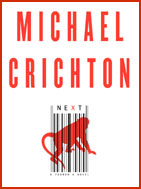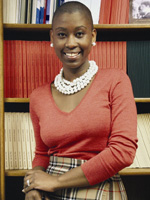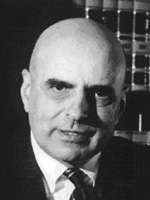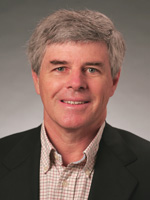On Monday, May 21, 2007, the Institute for Science, Law & Technology, at the Illinois Institute of Technology held a conference titled Who Owns Your Body? Legal and Social Issues in Michael Crichton’s NEXT. Lori Andrews, the Director of the Institute and a Distinguished Professor of Law at Chicago-Kent College of Law, convened the conference to discuss issues such as gene patents, selling body parts, and the intersection between commercial products and scientific research.
 Michael Crichton has written a number of scientific thrillers like Jurassic Park and The Andromeda Strain, and he told the conference about the technical reviews his latest novel has received. Next looks at the rapidly developing world of genetics and other medical technology, and while it is grounded in the latest research, Crichton told the audience that the technical reviewers of his book seemed to be unaware of the recent developments in the medical field. He speculates that biology is changing too rapidly for even the biologists to keep up with everything. The materials for the conference include the “Author’s Note” from Next, and in the Note, Crichton makes a strong argument that patenting genes is harmful. One of the examples he cites is that research on SARS was impeded because after three different patents were filed on the virus’s genome, researchers were worried about infringing the potential patent. The implication that arose from the combination of his book excerpt and his talk was that the pace of change in biology is good because it means that we are developing exciting new technologies and therapies, but gene patents are damaging because they slow down the pace of change without any benefit to the public.
Michael Crichton has written a number of scientific thrillers like Jurassic Park and The Andromeda Strain, and he told the conference about the technical reviews his latest novel has received. Next looks at the rapidly developing world of genetics and other medical technology, and while it is grounded in the latest research, Crichton told the audience that the technical reviewers of his book seemed to be unaware of the recent developments in the medical field. He speculates that biology is changing too rapidly for even the biologists to keep up with everything. The materials for the conference include the “Author’s Note” from Next, and in the Note, Crichton makes a strong argument that patenting genes is harmful. One of the examples he cites is that research on SARS was impeded because after three different patents were filed on the virus’s genome, researchers were worried about infringing the potential patent. The implication that arose from the combination of his book excerpt and his talk was that the pace of change in biology is good because it means that we are developing exciting new technologies and therapies, but gene patents are damaging because they slow down the pace of change without any benefit to the public.
The first panel was billed “Disputes Over Body Tissue” and the panelists also talked about patenting genes and using the genetic information of others for personal gain. The conference panelists were from diverse backgrounds–law professors, a former judge, a journalist, an anthropologist, a sociologist, and an economist. This sounds like the cast from a Crichton novel, and like any good thriller, the story must include an everyman. Joshua Greenberg was the conference’s everyman–a recent high school graduate with fantastic speaking skills and a fascinating story. His brother and sister have a rare genetic disease so his family worked closely with researchers to develop tests and therapies for the disease. His family donated a lot of time and money, and the researchers repaid their kindness by patenting their findings and charging others a ton of money for the products. The Greenbergs are livid and want their sacrifices to benefit everyone. Joshua agrees with Crichton that genes should not be patented and after listening to Josh’s story, the audience agreed that patenting genes is bad policy and that property interests in body parts should not be recognized.
 Michele Goodwin, a professor at DePaul College of Law, told even more harrowing stories about American tissue banks. Hatchetmen in morgues and funeral homes are chopping up the dead and selling the body parts to doctors and hospitals that then transplant them into patients. The recipients are generally happy until they find out that the tendon they thought came from a 29-year-old car accident victim really came from a geriatric cancer victim. When the transplant recipient tries to sue for a defective product, the courts throw the cases out–product liability only extends to products, and since body parts are not property, they cannot be a product.
Michele Goodwin, a professor at DePaul College of Law, told even more harrowing stories about American tissue banks. Hatchetmen in morgues and funeral homes are chopping up the dead and selling the body parts to doctors and hospitals that then transplant them into patients. The recipients are generally happy until they find out that the tendon they thought came from a 29-year-old car accident victim really came from a geriatric cancer victim. When the transplant recipient tries to sue for a defective product, the courts throw the cases out–product liability only extends to products, and since body parts are not property, they cannot be a product.
The courts are treating tissue banks like blood banks and calling the body parts that they are selling, sorry I mean providing, to recipients a service instead of a product. Professor Goodwin says that the tissue banks even are trying to have their cake and eat it too by taking out insurance on the tissues. If the tissue is stolen, then they can file an insurance claim for the stolen property, but if they are sued for a defective product, then they call the tissue a service, and deny that it is property. The audience was clearly outraged, and when she suggested that we treat body parts more like property, everyone agreed.
Debra Harry, the Executive Director of the Indigenous Peoples Council on Biocolonialism, described how researchers are treating indigenous peoples as knowledge databases to be searched or genetic mountains to be mined. Native cultures are finding that their genetic differences and their traditional medicines are being patented by researchers outside of their community. The result is that someone else owns their genes and medicines based on their traditional knowledge. She argues that the indigenous peoples collectively hold this knowledge and that it is inalienable. Although her argument is counter to Professor Goodwin’s, it makes sense and the audience agrees that property rights that result from biocolonialism are a bad idea.
 Possibly the most famous case dealing with gene patents and tissue ownership is Moore v. Regents of the University of California, 51 Cal. 3d 120, 271 Cal. Rptr. 146, 793 P.2d 479 (1990) (available free on the Supreme Court of California’s website). In that case, Moore’s doctor used cells from Moore’s removed spleen to create, and patent, a new cell line that was a potential therapy for others. The California Supreme Court held that Moore did not have a property right in his removed spleen, and therefore did not have a property right to the patent based on cells of the removed spleen. Justice Armand Arabian wrote a concurring opinion, and he reminded the audience that reducing human tissue to mere property is to put the human body on par with potato chips and used auto parts. Granting a property right to Moore would give him the power to prevent his doctors from using his cells for research and therefore from creating therapies to treat other sick people. If treating a removed spleen like property means inhibiting scientific progress, then how can we possibly treat body parts as property?
Possibly the most famous case dealing with gene patents and tissue ownership is Moore v. Regents of the University of California, 51 Cal. 3d 120, 271 Cal. Rptr. 146, 793 P.2d 479 (1990) (available free on the Supreme Court of California’s website). In that case, Moore’s doctor used cells from Moore’s removed spleen to create, and patent, a new cell line that was a potential therapy for others. The California Supreme Court held that Moore did not have a property right in his removed spleen, and therefore did not have a property right to the patent based on cells of the removed spleen. Justice Armand Arabian wrote a concurring opinion, and he reminded the audience that reducing human tissue to mere property is to put the human body on par with potato chips and used auto parts. Granting a property right to Moore would give him the power to prevent his doctors from using his cells for research and therefore from creating therapies to treat other sick people. If treating a removed spleen like property means inhibiting scientific progress, then how can we possibly treat body parts as property?
The first panel gave the audience whiplash. Joshua Greenberg’s story convinced the conference audience to say, “No!” to property rights in human bodies, but then Professor Goodwin showed us that the best way to stop hatchetmen was to implement property rights. Debra Harry showed that some knowledge and genetic information should probably be inalienable, and Justice Arabian reinforced this idea by telling the audience that it is immoral to treat a spleen like a diamond ring. During the question and answer session, a conference attendee, Professor Sarah Harding suggested a resolution to the apparently conflicting conclusions. She proposed that the “schizophrenia” over the property issue might indicate that property is not the right area of law to manage these issues–maybe we need a new legal regime to deal with genes and tissues.
 After the conclusion of the first panel, the audience was looking for a reason to separate tissues and genes from the property system, and they expected to find those reasons during the second panel — “Intellectual Property and Gene Patents.” Seth Shulman, a science and technology journalist, persuasively argued that the patent system was designed to protect “gadgets” such as toasters, but that it is ill suited for the knowledge-based economy. In areas such as computer programming and gene patents, the patents seem to be fundamentally different from earlier patents because the patents are not for “gadgets.” He quotes the former president of Mentrix Software Inc., Wallace Judd, as saying “Rather than encouraging people to design a better mousetrap, the current patent system too often grants a monopoly on the idea of trapping mice.” He calls a patent on an idea an “upstream patent” and argues that because other people have to get a license to use the upstream patent that the upstream patent restricts downstream product development.
After the conclusion of the first panel, the audience was looking for a reason to separate tissues and genes from the property system, and they expected to find those reasons during the second panel — “Intellectual Property and Gene Patents.” Seth Shulman, a science and technology journalist, persuasively argued that the patent system was designed to protect “gadgets” such as toasters, but that it is ill suited for the knowledge-based economy. In areas such as computer programming and gene patents, the patents seem to be fundamentally different from earlier patents because the patents are not for “gadgets.” He quotes the former president of Mentrix Software Inc., Wallace Judd, as saying “Rather than encouraging people to design a better mousetrap, the current patent system too often grants a monopoly on the idea of trapping mice.” He calls a patent on an idea an “upstream patent” and argues that because other people have to get a license to use the upstream patent that the upstream patent restricts downstream product development.
 Timothy Caulfield, the Research Director of the Health Law Institute at the University of Alberta, has studied the effects of gene patents on health-care research and the clinical care that patients receive. The audience of the conference fully expected Professor Caulfield to detail the carnage that gene patents have wrought. He told the audience, however, that patents for genes seem to be working as designed. His studies have been unable to find that gene patents have caused serious problems for researchers. Yes, his studies have shown that consumers of health products have paid higher prices for products and services, but he gently reminded the audience that is exactly what a patent is supposed to do–encourage research by granting an exclusive right to the owner to charge higher prices for the product. This was almost as disappointing as finding out that Professor Snape was a good guy in the first Harry Potter movie. We wanted to hate gene patents and Professor Caulfield made us think that they might actually be working as intended. Thanks a lot, Professor Caulfield.
Timothy Caulfield, the Research Director of the Health Law Institute at the University of Alberta, has studied the effects of gene patents on health-care research and the clinical care that patients receive. The audience of the conference fully expected Professor Caulfield to detail the carnage that gene patents have wrought. He told the audience, however, that patents for genes seem to be working as designed. His studies have been unable to find that gene patents have caused serious problems for researchers. Yes, his studies have shown that consumers of health products have paid higher prices for products and services, but he gently reminded the audience that is exactly what a patent is supposed to do–encourage research by granting an exclusive right to the owner to charge higher prices for the product. This was almost as disappointing as finding out that Professor Snape was a good guy in the first Harry Potter movie. We wanted to hate gene patents and Professor Caulfield made us think that they might actually be working as intended. Thanks a lot, Professor Caulfield.
Dr. Stephen Hilgartner studies the social impact of genetics issues, including gene patents, at Cornell University. He saved the conference audience from despair by showing not only how the patent system has changed, but also what social forces led to the change. He argued that while the patent system previously focused on inducing inventions and disclosure of those inventions, that it is now entirely focused on property rights, and that innovation is a by-product at best. The new focus of the patent system, and how patent holders use the patent system, has led to the development of “managerial rights” that flow from the right of exclusion. These managerial rights effectively allow the patent holder to make decisions about health care for patients and doctors. Terrible! Even worse, private individuals, not public entities, make the decisions, so the decisions are opaque, and it is not always clear that the public health is being served. Pure evil. The potential abuse by patent holders has brought the intellectual patent system into the spotlight, and the public is demanding changes.
 The final speaker for this panel was Dr. John M. Conley, who studies law and anthropology, and specifically the culture of lawyers in law firms. He was probably happy to study something other than Type-A personalities working long hours, drinking soy lattes, and obsessing over the size of their offices. His presentation was jam packed, and in less than 20 minutes, he explained: 1) how DNA replication works; 2) that DNA is made up of active and inactive sections; 3) how the active sections of DNA are transcribed by RNA, which makes proteins; 4) how scientists create “artificial” genes that are functionally similar to the real genes, but are structurally different because the artificial genes do not have the inactive sections; and 5) how these artificial genes fit our current system of patents. He points out that gene patents might actually make sense because the inventors created something that did not originally exist in nature. Even though gene patents seem to be the type of innovation that the patent system was designed to encourage, Professor Conley suggests that courts may limit them soon. First, he points out that the Supreme Court has only decided one gene patent case–in 1980! Furthermore, in 2006, the Supreme Court granted cert for Lab. Corp. v. Metabolite, asked for briefs about whether the process for diagnosing vitamin deficiencies was a patent on the laws of nature, but then dismissed the cert as improvidently granted. Professor Conley ponders whether the strong dissents of Justices Breyer, Stevens, and Souter means that those justices would vote to limit gene patents and other similar patents. He also tells us that courts may start striking down gene patents because they are obvious. The process of making an artificial gene is brilliant and innovative, but so is the process of using steel beams to make buildings. Just as it is obvious to use steel beams to make high-rise buildings today, it is now obvious to make artificial genes out of real genes.
The final speaker for this panel was Dr. John M. Conley, who studies law and anthropology, and specifically the culture of lawyers in law firms. He was probably happy to study something other than Type-A personalities working long hours, drinking soy lattes, and obsessing over the size of their offices. His presentation was jam packed, and in less than 20 minutes, he explained: 1) how DNA replication works; 2) that DNA is made up of active and inactive sections; 3) how the active sections of DNA are transcribed by RNA, which makes proteins; 4) how scientists create “artificial” genes that are functionally similar to the real genes, but are structurally different because the artificial genes do not have the inactive sections; and 5) how these artificial genes fit our current system of patents. He points out that gene patents might actually make sense because the inventors created something that did not originally exist in nature. Even though gene patents seem to be the type of innovation that the patent system was designed to encourage, Professor Conley suggests that courts may limit them soon. First, he points out that the Supreme Court has only decided one gene patent case–in 1980! Furthermore, in 2006, the Supreme Court granted cert for Lab. Corp. v. Metabolite, asked for briefs about whether the process for diagnosing vitamin deficiencies was a patent on the laws of nature, but then dismissed the cert as improvidently granted. Professor Conley ponders whether the strong dissents of Justices Breyer, Stevens, and Souter means that those justices would vote to limit gene patents and other similar patents. He also tells us that courts may start striking down gene patents because they are obvious. The process of making an artificial gene is brilliant and innovative, but so is the process of using steel beams to make buildings. Just as it is obvious to use steel beams to make high-rise buildings today, it is now obvious to make artificial genes out of real genes.
After all of the presentations, it is clear that there are problems with buying and selling body parts and with property rights in genes. At some points in the conference, it appeared that the problems were so large that the entire property system needed to be overhauled, but after closer examination it appears that the property system merely needs to be tweaked. Furthermore, there were times during the conference where the participants were ready to take up arms to fix the problems, but after some reflection, it appears that the self-correction in the judicial system may fix most of the issues. Some help from Congress may be useful, and many of the panelists and most of the audience would like to see House Bill 977 passed.
With all of the twists and turns of the conference and with all of the colorful characters, I am sure that Crichton’s next book will star Lori Andrews and her all-star team of intellectuals striving to solve a problem that is solving itself. Oh wait, that was the plot from The Andromeda Strain, so maybe Professor Andrews needs to bring Dr. Crichton back for another conferece.
My thanks go to Professor Henry H. Perritt, Jr. and Professor Andrews for their help.
Chicago-Kent student-blogger Hunter Hogan wrote this of the recent ISLAT conference entitled “Who Owns Your Body?”:
The audience of the conference fully expected Professor Caulfield to detail the carnage that gene patents have wrought. [Caulfield] told the audience, however, that patents for genes seem to be working as designed. His studies have been unable to find that gene patents have caused serious problems for researchers.
Indeed, Caulfield recently asked “academic biomedical researchers in the United States” to self-report instances when they had delayed or abandoned a project because of a gene patent. “[O]nly 1%” reported that a patent had caused them to delay a project, and “none” reported abandoning a project because of a patent. These results, taken alone, seem to suggest that gene patents are not hampering research efforts; however, several caveats should be noted.
First, Caulfield was quick to acknowledge credible evidence suggesting that gene patents have negatively impacted researchers who use genetics to develop diagnostic tools. This caveat is telling of the coming conflicts between researchers and gene patent owners. Diagnostics is currently the most established, most profitable field of genetic research. With concrete profits at stake, patent holders are likely to sue to enforce their rights. Researchers recognize this risk and shift their practices accordingly. In other fields of genetic research, profitability is not yet a reality. But as those fields mature, patent holders will have the same incentive to enforce their rights as currently exists in the diagnostics world – and gene patents will likely hamper research across the board.
The results of Caulfield’s study also may have been skewed by the methodology of interviewing only academic researchers. There is a persistent belief among academic researchers that they are shielded from liability for patent infringement. That belief is not grounded in the law. The Court of Appeals for the Federal Circuit severely limited any common law experimental use exception that may have existed previously in Madey v. Duke, stating the “experimental use defense is very narrow and limited to actions performed for amusement, to satisfy idle curiosity, or for strictly philosophical inquiry.” Accordingly, research pursuant to any commercial purpose, including the business of education, is not exempt from findings of patent infringement.
Yet a false sense of confidence could be leading many researchers to ignore patents simply because they fear no repercussions. But if patent holders begin to aggressively litigate their rights, as anticipated above, then the tenor of the research community will shift dramatically. Additionally, the effect of gene patents on research is more accurately depicted when surveys elicit the response of individuals who actually review research proposals, such as laboratory directors. These individuals are generally more cognizant of the effects that gene patents have upon their institutions’ research endeavors.